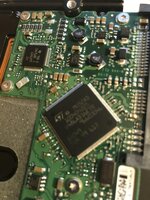victor6799
Junior Member level 2

Hello. I have an old Seagate SATA 320GB HDD. The model number is ST3320620AS product number 9BJ14G-300. I've attached a photo of the drive's PCB which shows two main chips. Can anyone help me identify what these chips are and what are their role ? Would one of them be called a HDD Controller ? If yes then what is this role for this IC ?
Thanks
Victor
Thanks
Victor

